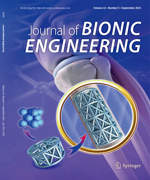In this study, to fabricate dual-pore scaffolds with interconnected pores, Non-solvent Induced Phase Separation (NIPS) and Wire-Network Molding (WNM) techniques were combined. First, a mold with uniform slits was prepared, and needles were inserted into the mold. Subsequently, polycaprolactone (PCL) pellets were dissolved in tetrahydrofuran (THF) at a specified ratio. The slurry was mixed using hot plate stirrer at 1200 rpm for 24 hours at 40 ?C. The PCL slurry was subsequently injected into the mold. Thereafter, to exchange the THF (solvent) with the ethanol (non-solvent), the mold was soaked in an ethanol bath. After removing the mold from the ethanol bath, the needles were removed from the mold. Consequently, dual-pore scaffold with interconnected pores was obtained. The surface morphology of the fabricated scaffolds were observed using Scanning Electron Microscope (SEM). Moreover, cell culture experiments were performed using the CCK-8 assay, and the characteristics of cells grown on the dual-pore scaffolds were assessed and were compared with the NIPS-based 3D plotting scaffold.

 Table of Content
Table of Content
 Table of Content
Table of Content